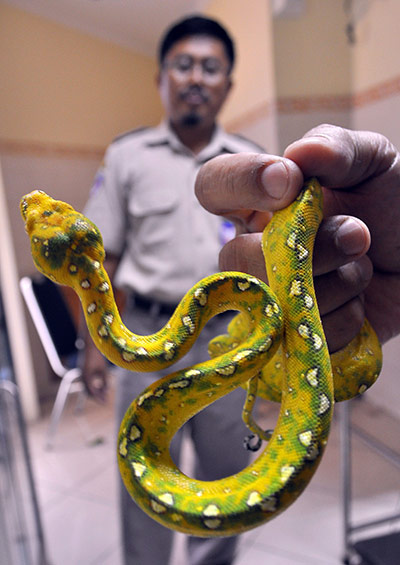TOP STORIES
NI red squirrels face new threat of fatal pox
... Squirrel pox, which is carried by the non-native grey squirrel, has been confirmed as the cause of death for a native red squirrel in Tollymore Forest Park, County Down.
non-native grey squirrel, has been confirmed as the cause of death for a native red squirrel in Tollymore Forest Park, County Down.
The disease is carried and spread by grey squirrels which are immune to its effects.
It has destroyed native red squirrel populations in other parts of the UK.
Senior Wildlife Inspector Dr Declan Looney from the NI Environmental Agency said: "This is the first recorded instance of a red squirrel dying from this disease on the island of Ireland and it is a very worrying development.
"Our native red squirrel population is under extreme pressure at the moment as a result of the population explosion of the grey.
01 Apr 2011
Location: Tollymore Forest Park, Ireland - Map It

Photo courtesy of BBC News
Wildlife officials find fatal bat fungus in Ohio
A fungus that has killed more than one million bats in eastern North America has spread to Ohio, state wildlife officials said.
The disease that causes lesions on bats' muzzles was found recently in bats in an abandoned limestone mine in the Wayne National Forest in southern Ohio's Lawrence County, according to the Ohio Department of Natural Resources.
31 Mar 2011
Location: Wayne National Forest, Ohio, USA - Map It

 Bats Worth Billions to Agriculture: Pest-control Services at Risk
Bats Worth Billions to Agriculture: Pest-control Services at RiskPest-control services provided by insect-eating bats in the United States likely save the U.S. agricultural industry at least $3 billion a year, and yet insectivorous bats are among the most overlooked economically important, non-domesticated animals in North America, according to an analysis published in this week’s Science magazine Policy Forum.
"People often ask why we should care about bats,” said Paul Cryan, a U.S. Geological Survey research scientist and one of the study’s authors. “This analysis suggests that bats are saving us big bucks by gobbling up insects that eat or damage our crops. It is obviously beneficial that insectivorous bats are patrolling the skies at night above our fields and forests — these bats deserve help."
The value of the pest-control services to agriculture provided by bats in the U.S. alone range from a low of $3.7 billion to a high of $53 billion a year, estimated the study’s authors, scientists from the University of Pretoria (South Africa), USGS, University of Tennessee and Boston University. They also warned that noticeable economic losses to North American agriculture could occur in the next 4 to 5 years as a result of emerging threats to bat populations.
31 Mar 2011
[Includes podcast]
Cited Journal Article
A six session on-line preparatory course accompanies the workshop and must be completed prior to attending. For additional information and registration instructions, please visit the Raptor Center website here.
OTHER WILDLIFE HEALTH RELATED NEWS
Photo courtesy of The Guardian - Week in Wildlife
 Oil spill wildlife impact estimate off
Oil spill wildlife impact estimate off- Wild waterfowl, avian influenza and biodiversity [Courtesy of Australian Wildlife Heath Network]
- Report Finds Lax Monitoring of Wildlife Trade
- Dead right whale washes ashore in Nags Head [North Carolina, USA - Map It
 ]
] - Tackling a devil of a problem [Devil facial tumor disease]
- ProMed - Epizootic ulcerative syndronme, fish - Canada: Retraction
- Notre Dame Professor Leads Effort to Keep Asian Carp Out of Great Lakes
- CWD tests negative on trio of Allamakee County elk [Iowa, USA]
- Ten Kansas Deer Confirmed Positive In CWD Tests [KDWP Press Release] [Kansas, USA - Map It
 ]
]




